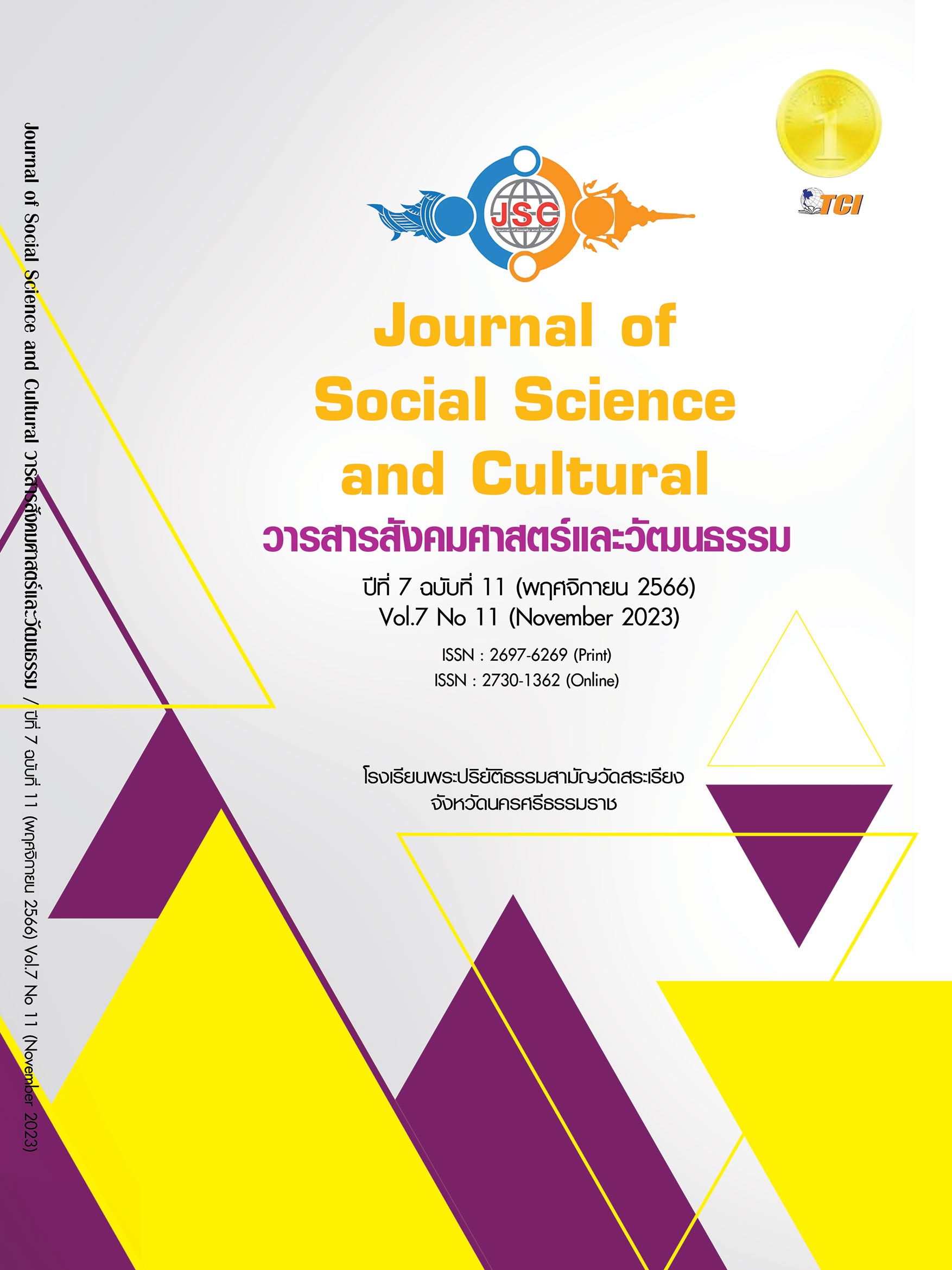(Retracted Article) EFFECTS OF TOILET TRAINING FOR A CHILD WITH SPEECH AND LANGUAGE IMPAIRMENTS AND INTELLECTUAL DISABILITIES BY USING PICTURE EXCHANGE COMMUNICATION SYSTEM AND POSITIVE REINFORCEMENT
Main Article Content
Abstract
This research article aimed to investigate the effects of training in expressing a need to use a toilet under a case study of a child with speech and language impairment and intellectual disability using picture exchange communication system and positive reinforcement. A case study was a 14-year-old boy diagnosed by a physician with speech and language impairments and intellectual disabilities, having communication problems and being unable to express his needs. The research instruments were 1) a positive reinforcement survey, 2) a behavior observation form based on picture exchange communication system to express a need to use a toilet, 3) three individualized education plans, learning unit on going to the toilet. Data were collected from November to December 2021. By organizing activities to teach skills in expressing the need to go to the bathroom using a communication system, exchanging pictures and positive reinforcement in real situations, allowing the case study to participate and practice on its own in the case study classroom. Data were analyzed using frequencies, means, and percentages. The study results indicated that after receiving training in using the communication system to exchange pictures and positive reinforcement in expressing the need to go to the bathroom. Case studies have higher communication skills. Able to express the need to go to the bathroom using the picture exchange communication system, the case study was able to express his need in procedure 1 by 100 %, in procedure 2 (2A-1) by 100 % and in procedure 2 (2A-2) by 100 %. After practicing the picture exchange communication system and positive reinforcement for 10 days, the case study was able to use and had stable development of the picture exchange communication system. From both procedures, the study results indicated that the case study had better development of communication skills as he was able to express his need to use a toilet by using the picture exchange communication system on his own.
Article Details
References
กระทรวงพัฒนาสังคมและความมั่นคงของมนุษย์. (2550). พระราชบัญญัติส่งเสริมและพัฒนาคุณภาพชีวิตคนพิการ พ.ศ. 2550. กรุงเทพมหานคร: สำนักงานส่งเสริมและพัฒนาคุณภาพชีวิตคนพิการแห่งชาติ.
กระทรวงศึกษาธิการ. (2552). กำหนดประเภทและหลักเกณฑ์ของคนพิการทางการศึกษา พ.ศ. 2552. กรุงเทพมหานคร: คุรุสภาลาดพร้าว.
กระทรวงสาธารณสุข. (2558). คู่มือเฝ้าระวังและส่งเสริมพัฒนาการเด็กปฐมวัย. นนทบุรี: สำนักงานกิจการโรงพิมพ์องค์การสงเคราะห์ทหารผ่านศึก.
คณะแพทยศาสตร์ศิริราชพยาบาล. (2562). การฝึกขับถ่ายของลูกน้อย. เรียกใช้เมื่อ 6 มกราคม 2563 จาก https://www.si.mahidol.ac.th/sidoctor/e-pl/admin/article_files/1396_1.pdf
จริยา บุตรทอง. (2563). การพัฒนาทักษะการสื่อสารโดยใช้วิธีการสอนเพ็คส์ (PECS) ร่วมกับหลักการสอนแบบ 3 R's สำหรับเด็กออทิสติก ศูนย์การศึกษาพิเศษมหาจักรีสิรินธร ประจำจังหวัดนครนายก. ใน วิทยานิพนธ์ศึกษาศาสตรมหาบัณฑิต สาขาวิชาการพัฒนาหลักสูตรและนวัตกรรมการสอน. มหาวิทยาลัยเทคโนโลยีราชมงคลธัญบุรี.
ฐาวรี ขันสำโรง และเมธิศา พงษ์ศักดิ์ศรี. (2560). การพัฒนาทักษะการสื่อสารด้วย PECS สำหรับบุคคลออทิสติก. เรียกใช้เมื่อ 26 ธันวาคม 2562 จาก https://www.western.ac.th/media/attachments /2017/12/06/002-pecs-lipof
ณัฏฐ์นรินทร์ นาคเล็ก. (2557). การพัฒนาความสามารถในการสื่อสารของเด็กออทิสติกจากการสอนโดยวิธีเพ็คส์ (PECS). ใน วิทยานิพนธ์ครุศาสตรมหาบัณฑิต สาขาวิชาการศึกษาพิเศษ. มหาวิทยาลัยราชภัฏสงขลา.
ณัฐณิชา กองจันทร์. (2557). การใช้เทคนิคการเสริมแรงทางบวกเพื่อพัฒนาทักษะการดูแลผิวของนักเรียนสมองพิการ. ใน สารนิพนธ์ศึกษาศาสตรมหาบัณฑิต สาขาวิชาการศึกษาพิเศษ. มหาวิทยาลัยเชียงใหม่.
ตุลชาติ ชุ่มชื่น. (2562). ผลของการใช้ชุดฝึกการขับถ่าย โดยการมีส่วนร่วมของผู้ปกครองที่มีต่อทักษะการช่วยเหลือตนเองด้านการขับถ่ายของเด็กที่มีความบกพร่องทางสติปัญญา ระดับปานกลาง. วารสารวิจัยและพัฒนาการศึกษาพิเศษ, 8(2), 24-40.
ปัณณ์พัฒน์ จันทร์สว่าง. (2558). เด็กพิการซ้อน (Children with Multiple Disabilities). เรียกใช้เมื่อ 26 ธันวาคม 2562 จาก https://fcdthailand.org/library-type/
พระราชบัญญัติส่งเสริมและพัฒนาคุณภาพชีวิตคนพิการ พ.ศ. 2550. (2550). ราชกิจจานุเบกษา เล่ม 124 ตอนที่ 61 ก หน้า 8 (27 กันยายน 2550).
ภทรา นาพนัง. (2563). การใช้โปรแกรมทีช และการเสริมแรงทางบวกเพื่อเพิ่มการกำกับตนเองของเด็กปฐมวัยที่มีภาวะออทิซึม. ใน วิทยานิพนธ์ศึกษาศาสตรมหาบัณฑิต สาขาวิชาการศึกษาพิเศษ. มหาวิทยาลัยเชียงใหม่.
ยงยุทธ สอนใจดี. (2558). ประเภทของแรงเสริมแรงทางบวก. เรียกใช้เมื่อ 26 ธันวาคม 2562 จาก https://fcyongyut.wordpress.com/2015/06/30/
ยอดขวัญ ทองเล่ม. (2557). การใช้รูปภาพเพื่อพัฒนาทักษะการออกเสียงของเด็กที่มีความบกพร่องทางการได้ยิน. ใน สารนิพนธ์ศึกษาศาสตรมหาบัณฑิต สาขาวิชาการศึกษาพิเศษ. มหาวิทยาลัยเชียงใหม่.
ลักขณาพร ทองเจือเพชร. (2551). ผลการใช้วิธีเพ็คส์ในการพัฒนาทักษะการสื่อสารของเด็กที่มีความบกพร่องทางสติปัญญา. ใน สารนิพนธ์การศึกษามหาบัณฑิต สาขาวิชาการศึกษาพิเศษ. มหาวิทยาลัยศรีนครินทรวิโรฒ.
สมเกตุ อุทธโยธา. (2556). การเรียนรวมสำหรับเด็กที่มีความต้องการพิเศษในโรงเรียนปกติ. (พิมพ์ครั้งที่ 11). เชียงใหม่: แพรวการพิมพ์.
สมโภชน์ เอี่ยมสุภาษิต. (2550). ทฤษฎีและเทคนิคการปรับพฤติกรรม. กรุงเทพมหานคร: สํานักพิมพ์จุฬาลงกรณ์มหาวิทยาลัย.
สมโภชน์ เอี่ยมสุภาษิต. (2556). ทฤษฎีและเทคนิคการปรับพฤติกรรม. (พิมพ์ครั้งที่ 8). กรุงเทพมหานคร: โรงพิมพ์แห่งจุฬาลงกรณ์มหาวิทยาลัย.
เอกสุรีย์ พรสุริยชัย. (2556). การชี้แนะด้วยการเสนอตัวแบบร่วมกับการเสริมแรงทางบวกเพื่อพัฒนาพฤติกรรมทางสังคมในการรับประทานอาหารกลางวันของเด็กออทิสติก. ใน สารนิพนธ์ศึกษาศาสตรมหาบัณฑิต สาขาวิชาจิตวิทยาการศึกษาพิเศษ. มหาวิทยาลัยศิลปากร.
Berlo, D. K. (1960). The Process of Communication: An Introduction to Theory And Practice. New York: Holt, Rinehart and Winston.
Frost, L. & Bondy, A. (2002). The picture exchange communication system: PECS training manual. (2nd ed.). Newark: Pyamid Education Products.
Grant. (2013). Toilet Training Children with Developmental Delays. USA: Maternal and Child Health Bureau (MCHB), Health Resources and Services Administration (HRSA), Department of Health and Human Services (HHS).
Hilton, L. C. (2015). Assessing the Effectiveness of a Picture Exchange Communication System on Increasing Manding and Vocal Speech in Identical Twin Adults with Autism. In Dissertation for the degree of Doctor of Philosophy Psychology. Western Michigan University.


